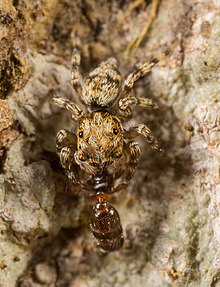Habrocestum
Habrocestum is a genus of jumping spiders first described in 1876.[2] They mostly occur in Eurasia and Africa, though one species has been found in Australia and another on the Solomon Islands.[1]
| Habrocestum | |
|---|---|
 | |
| H. hongkongiense, eating an ant | |
| Scientific classification | |
| Kingdom: | Animalia |
| Phylum: | Arthropoda |
| Subphylum: | Chelicerata |
| Class: | Arachnida |
| Order: | Araneae |
| Infraorder: | Araneomorphae |
| Family: | Salticidae |
| Genus: | Habrocestum Simon, 1876[1] |
| Type species | |
| Habrocestum pullatum Simon, 1876[1] | |
| Species | |
|
See text. | |
| Diversity | |
| 49 species | |
Species
As of February 2019, the World Spider Catalog accepted the following species:[1]
- Habrocestum africanum Wesołowska & Haddad, 2009 – South Africa
- Habrocestum albimanum Simon, 1901 – South Africa
- Habrocestum albopunctatum Wesołowska & van Harten, 2002 – Socotra
- Habrocestum algericum Dalmas, 1920 – Algeria
- Habrocestum arabicum Prószynski, 1989 – Saudi Arabia
- Habrocestum auricomum Haddad & Wesołowska, 2013 – South Africa
- Habrocestum bovaei (Lucas, 1846) – Morocco, Algeria, Spain
- Habrocestum dubium Wesołowska & van Harten, 2002 – Socotra
- Habrocestum egaeum Metzner, 1999 – Greece, Crete, Turkey
- Habrocestum ferrugineum Wesołowska & van Harten, 2002 – Socotra
- Habrocestum flavimanum Simon, 1901 – South Africa
- Habrocestum formosum Wesołowska, 2000 – Zimbabwe
- Habrocestum gibbosum Wesołowska & van Harten, 2007 – Yemen
- Habrocestum graecum Dalmas, 1920 – Greece
- Habrocestum hantaneensis Kanesharatnam & Benjamin, 2016 – Sri Lanka
- Habrocestum hongkongiense Prószynski, 1992 – Hong Kong
- Habrocestum ibericum Dalmas, 1920 – Spain
- Habrocestum ignorabile Wesołowska & van Harten, 2007 – Yemen
- Habrocestum inquinatum Wesołowska & van Harten, 2002 – Yemen, Socotra
- Habrocestum kodigalaensis Kanesharatnam & Benjamin, 2016 – Sri Lanka
- Habrocestum latifasciatum (Simon, 1868) – Eastern Mediterranean to Near East
- Habrocestum laurae Peckham & Peckham, 1903 – South Africa
- Habrocestum lepidum Dalmas, 1920 – Algeria
- Habrocestum longispinum Sankaran, Malamel, Joseph & Sebastian, 2019 – India
- Habrocestum luculentum Peckham & Peckham, 1903 – South Africa
- Habrocestum naivasha Dawidowicz & Wesołowska, 2016 – Kenya
- Habrocestum namibicum Wesołowska, 2006 – Namibia
- Habrocestum nigristernum Dalmas, 1920 – Turkey
- Habrocestum ohiyaensis Kanesharatnam & Benjamin, 2016 – Sri Lanka
- Habrocestum ornaticeps (Simon, 1868) – Morocco, Spain
- Habrocestum panjabium Roewer, 1951 – Pakistan
- Habrocestum papilionaceum (L. Koch, 1867) – Greece, Turkey
- Habrocestum peckhami Rainbow, 1899 – Solomon Is.
- Habrocestum penicillatum Caporiacco, 1940 – Ethiopia
- Habrocestum personatum Wesołowska & A. Russell-Smith, 2011 – Nigeria
- Habrocestum pullatum Simon, 1876 – France
- Habrocestum punctiventre Keyserling, 1882 – Western Australia
- Habrocestum sapiens (Peckham & Peckham, 1903) – Southern Africa
- Habrocestum schinzi Simon, 1887 – South Africa
- Habrocestum shulovi Prószyński, 2000 – Turkey, Israel
- Habrocestum simoni Dalmas, 1920 – Algeria
- Habrocestum socotrense Wesołowska & van Harten, 2002 – Socotra
- Habrocestum speciosum Wesołowska & van Harten, 1994 – Socotra
- Habrocestum subdotatum Caporiacco, 1940 – Ethiopia, East Africa
- Habrocestum subpenicillatum Caporiacco, 1941 – Ethiopia
- Habrocestum superbum Wesołowska, 2000 – Zimbabwe
- Habrocestum tanzanicum Wesołowska & Russell-Smith, 2000 – Tanzania
- Habrocestum verattii Caporiacco, 1936 – Libya
- Habrocestum virginale Wesołowska & van Harten, 2007 – Yemen
gollark: It's the same amount of computer. They have to do more work to replace heavy things with light things.
gollark: Did you know? [C++] is, by definition, better than C,[1] but most people are too feeble-minded to learn it, and usually die of an aneurism when they begin to learn how to use templates.[citation needed] Given the complexity of the language, only the best programmers can actually use it, and because of the necessary skills, the programs are always smaller, faster, and better than programs written in other languages.
gollark: Surely you could just have your code scan the entire contents of memory via ctypes every minute or so?
gollark: https://i.redd.it/x9dttazcllp81.jpg
gollark: That is LyricLy.
References
- "Gen. Habrocestum Simon, 1876". Natural History Museum Bern. Retrieved 2019-02-28.
- Simon, E. (1876). "Les arachnides de France". Tome troisième. Roret, Paris: 364 pp., pl. IX-XIII.
External links
This article is issued from Wikipedia. The text is licensed under Creative Commons - Attribution - Sharealike. Additional terms may apply for the media files.